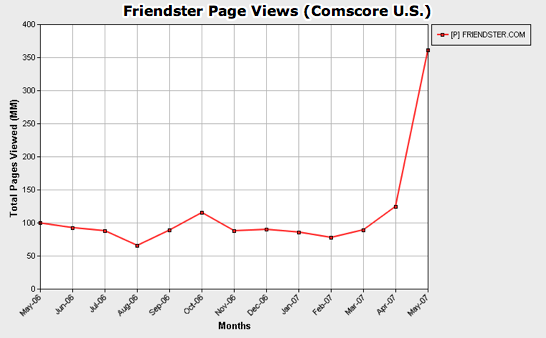 Friendster experienced a 40% page view growth rate in May, according to the latest comScore traffic figures published at Venturebeat.
Friendster experienced a 40% page view growth rate in May, according to the latest comScore traffic figures published at Venturebeat.
Friendster currently sits in 4th place on the list of popular social networking sites, behind MySpace, Facebook and Hi5, but ahead of Tagged.com, Bebo and Piczo.
In an age where everyone presumes that Facebook reigns supreme, the question becomes: how is it possible for Friendster to grow at 40%?
Prevailing theory relating to the growth of social networking sites suggests that social network popularity is a one or the other proposition in a finite marketplace. In others words users will abandon MySpace or Friendster when they begin using Facebook, and that the number of overall users isn’t growing. The growth rates from both MySpace and Friendster at the same time as Facebook is booming would suggest that the theory is wrong.
First, the one or the other proposition. As I noted on MySpace June 20, users have invested time and effort on existing sites and many will not want to give this up, particularly when the feature set of the alternative service (in this case Facebook) is not the same (personalization). Conversely users do want to link to friends where ever they are, creating a demand for multiple social networking memberships. In the same way that many may use Flickr for photos on Yahoo and Google for everything else, social network users may simply maintain different friend sets on each service, and will maintain participation on both. One is not used instead of the other.
Secondly, the overall market is growing. As noted in the Venturebeat article Friendster is experiencing rapid growth in Malaysia and the Philippines. There is a market place outside of the United States; only 4.53% of the world’s population lives in the United States (wikipedia), China will have more broadband users than the United States in the next 12-18 months and India has the largest number of English speaking people of any country worldwide. Smart startups build products that appeal to a global audience, an audience which provides a wealth of growth opportunities at much higher rates than in a mature marketplace such as the United States.
Friendster growing is good for the entire Web 2.0 industry. There can be no downturn without a broad decline in user numbers across many sites. Friendster proves that despite strong, and some would argue superior competition, there’s still room for any Web 2.0 startup to grow, even in a crowded vertical marketplace. There is more Web 2.0 cake for everyone.
Comscore stats below:
